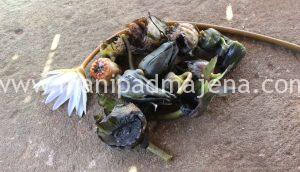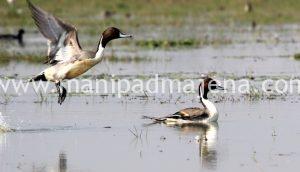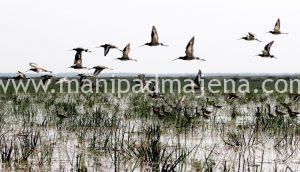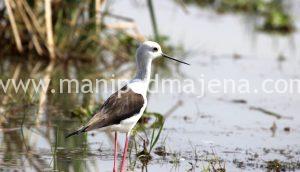
Warmer winters and fluctuating rainfall in Chilika Lake are proving to be major disruptors for the large population of migratory birds in this famous lagoon on India’s eastern coast.
It is only February but noon temperatures are already 34 degrees Celsius in the coastal state of Odisha. On its vast perennial Chilika lagoon, most of the 0.9 million birds that wintered here this season flying in from some of world’s coldest parts are leaving, even though in earlier years they lingered on to build body mass for the marathon return flight, and some species stayed on to breed.
“Winter temperatures in Chilika is higher today by 3 – 4 degrees Celsius compared with two decades back,” S. Balachandran, international expert on migratory birds at the Bombay Natural History Society (BNHS) a pan-India wildlife research organisation, told indiaclimatedialogue.net. “Winter days were (earlier) severely cold, and foggy, and the season was spread over a longer period.”
This helped birds migrating from the freezing Arctic to adjust gradually to the moderately cold winters in Chilika Lake. Climate change has skewed this slow adaptation process for migratory birds, some of which fly around 11,000 km to reach this wintering ground. Here they need to feed voraciously, increasing their body mass by 20-60%, an energy reserve to undertake the return journey.
“Fluctuations in rainfall, in addition to climate change impacts of temperature rise, is the other major disruptor for migratory birds,” said Balachandran. “Rainfall alters the quality of the brackish lake water and that is the problem.”
Due to the absence of winter rainfall, the brackish water can become too saline, resulting in freshwater-feeding birds not finding adequate food. On the other hand, intense rainfall would infuse too much freshwater through rivers draining into the lake, leaving brackish water feeders with insufficient food. “With climate change, some species could benefit, while many will not,” Balachandran said.
Endangered due to climate change
Climate change is already exacerbating many of the factors that have put one in eight of the world’s birds at risk of extinction, according to Britain-based BirdLife International, a global partnership of conservation organisations. One of its global studies said 15-37% of species could face extinction by 2050 as a consequence of climate change.
Another study assesses that with each degree of temperature rise, 100-500 bird species could go extinct. The present rate of change for wildlife is faster than that in the last 1,000 years and would be beyond the in-built threshold of many species to adapt.
Birds will be faced with the combined threat of habitat loss and climate space, according to an earlier study titled Impact of Climate Change and Habitat Degradation on the Avifauna. There is already a disruption in timing of insects’ emergence, a major source of bird food. Consequently, breeding and egg-laying timings of shore birds are changing.
Breeding of birds should synchronise with the abundance of food prey whose larvae development should in turn match the growth of leaves in a plant. For example, the Great Tit has to time its reproduction so that its babies have an abundance of caterpillars to feed on.
The root bulb of lotus plants abounding in Chilika is a favourite food of the Black-tailed Godwit and other waders that prefer shallow waters (Photo by Manipadma Jena)
Migratory disadvantage
While resident birds, which also winter in Chilika in large numbers, have more time to adapt to the changing life-cycles of their prey, migrant birds do not have this advantage.
A pair of male Northern Pintail ducks in Chilika in 2018, but their arrivals are declining. Often undertaking transoceanic journeys from Alaska, Canada, Mongolia and Poland to Odisha’s lagoon, these waterfowls are an excellent indicator of climate and developmental projects’ impacts on their habitats (Photo by Manipadma Jena)
Flying in from 29 countries, migrating birds have well-defined departure, stopover and arrival dates. The start of migration and their speed must match the life-cycle (for example, when a moth turns into a caterpillar) of food sources at the stopover and destination breeding sites.
As climate is not changing uniformly in all regions, the migrants have no cue as to what is in store for them. This results in either bird deaths or failure to migrate at all, which can also lead to mortality in severe winters in home grounds, experts said. In this, short and medium distance migratory birds are able to adapt taking longer but more sustainable routes, but the long distance ones find it difficult to re-adjust.
“While impact of climate change is difficult to measure the indicators say some birds species are coming in lower numbers to Chilika,” Balachandran told indiaclimatedialogue.net.
A five-year BNHS study (2012 to 2017) on Chilika’s water bird population and distribution, migration, disease surveillance and breeding habits finds partial shifting of the wintering population in Chilika to other sites located further south in Tamil Nadu and Karnataka. Among waders, the increasing trend observed for the globally near threatened Black-tailed Godwit in earlier years is showing a declining trend since 2014.
A flock of Black-tailed Godwit take flight as a Black Kite swoops to prey on their young. An IUCN-designated globally near-threatened shorebird species from Siberia, Central Asia and Iceland, their arrival in Chilika Lake, though uninterrupted, is declining in numbers since 2014 (Photo by Manipadma Jena)
“Earlier, plenty of black tailed godwits came but not many in the last few years. Similarly, we saw only one or two Bar-headed goose this year, but none in the preceding three years,” Ramahari Behera, a birding guide of Sri Mahavir Pakshi Surakshya Samiti, a community bird protection committee in northern Chilika’s Mangalajodi village, told indiaclimatedialogue.net. Mangalajodi sees one of the highest migratory bird congregations in the lagoon after Nalabana Island, a 15 sq. km bird sanctuary in the middle of the Lake.
“Arrival time for birds is changing but varies with different species. Those that can adapt adhere to their arrival and departure timings but it is very difficult to pinpoint these or generalise. Especially because Chilika is a perennial lake hosting a huge mass of water year round,” Balachandran said. In monsoons, Chilika Lake spreads to 1,165 sq. km. In the dry seasons, it still covers 906 sq. km.
A Chilika bird census in January 2018 counted 890,000 birds of 147 species. On average, annually 224 species were seen till 2009. Chilika is one of the few wetlands in India, which has species-wise bird population data for more than 15 years.
Ocean warming
Ocean warming will bring more serious knock-on effects on the food chain, experts warn. More frequent extreme events like cyclones, floods and heat waves are posing serious disruptions. Sea level rise is likely to snatch away the birds’ coastal habitats, including feeding areas for shore birds and entire island ecosystems that are critical for migratory birds. Flocks might fly thousands of kilometres only to find their destination submerged, while they are left without food.
“Sea level rise is another threat to the Chilika ecosystem and there is a possibility in two to three decades or more that the bird island Nalabana may get submerged,” Balachandran said.
According to a 2016 conservation study of Chilika lake by Wetlands International South Asia (WISA) and Chilika Development Authority (CDA), the Bay of Bengal has recorded the maximum annual sea level rise of 2.42 – 4.87 mm along the Indian coast. An increase in sea level by one metre is projected to inundate 1,700 km of agricultural land in Odisha. Puri district, one of the three districts that Chilika lake spans, has been identified to be the most vulnerable to a one-metre sea level rise, according to this study.
Changes in water temperatures can also trigger aquatic biodiversity alteration, the study said.
Searching for a standby bird habitat
There have been proposals to identify an island with similar ecology as Nalabana for the avian visitors, but it is not easy.
The bird sanctuary has a distinct seasonal cycle where it is completely submerged during the monsoon, and emerges during winter until late summer. These hydrological changes affect the growth, survival and reproduction of insects and submerged weeds, which serve as food for the visiting birds, making it an ideal bird habitat.
As the monsoon water level recedes exposing the mudflats in Nalabana, waders start congregating in these shallow areas. Birds remain largely confined to the island till October end and started dispersing to other feeding grounds within the lagoon from early November.
The Black-winged Stilt, a ground-nester from northern Asia, used to head straight for the Nalabana bird sanctuary, but not any more since the island’s mudflats have been invaded by tall grass after the new mouth opening in 2000 (Photo by Manipadma Jena)
“It’s not just climate change. Urban and developmental projects like ports, industries and jetties that cause land use change and deforestation can exacerbate impacts on migratory birds,” Balachandran said.
Quantifying climate impact on biodiversity including birds remains a difficult task owing to these forms of human interference, other bird experts said.
Read original article at: India Climate Dialogue http://indiaclimatedialogue.net/2018/02/21/climate-change-deal-body-blow-migratory-birds/




